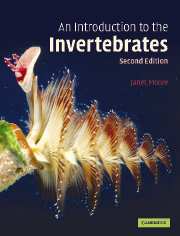Book contents
- Frontmatter
- Contents
- List of boxes
- Preface
- Acknowledgements
- Illustration acknowledgements
- Chapter 1 The process of evolution: natural selection
- Chapter 2 The pattern of evolution: methods of investigation
- Chapter 3 Porifera
- Chapter 4 Cnidaria
- Chapter 5 On being a worm
- Chapter 6 Platyhelminthes and Acoelomorpha
- Chapter 7 Nemertea
- Chapter 8 Nematoda
- Chapter 9 Annelida
- Chapter 10 Mollusca: general and Gastropoda
- Chapter 11 Mollusca: Bivalvia and Cephalopoda
- Chapter 12 Arthropoda: general
- Chapter 13 Crustacea
- Chapter 14 Chelicerata and Myriapoda
- Chapter 15 Insecta
- Chapter 16 Animals with lophophores
- Chapter 17 Echinodermata
- Chapter 18 Invertebrate Chordata and Hemichordata
- Chapter 19 Development
- Chapter 20 Invertebrate evolutionary history
- Further reading
- Glossary
- Index
Chapter 2 - The pattern of evolution: methods of investigation
Published online by Cambridge University Press: 05 September 2012
- Frontmatter
- Contents
- List of boxes
- Preface
- Acknowledgements
- Illustration acknowledgements
- Chapter 1 The process of evolution: natural selection
- Chapter 2 The pattern of evolution: methods of investigation
- Chapter 3 Porifera
- Chapter 4 Cnidaria
- Chapter 5 On being a worm
- Chapter 6 Platyhelminthes and Acoelomorpha
- Chapter 7 Nemertea
- Chapter 8 Nematoda
- Chapter 9 Annelida
- Chapter 10 Mollusca: general and Gastropoda
- Chapter 11 Mollusca: Bivalvia and Cephalopoda
- Chapter 12 Arthropoda: general
- Chapter 13 Crustacea
- Chapter 14 Chelicerata and Myriapoda
- Chapter 15 Insecta
- Chapter 16 Animals with lophophores
- Chapter 17 Echinodermata
- Chapter 18 Invertebrate Chordata and Hemichordata
- Chapter 19 Development
- Chapter 20 Invertebrate evolutionary history
- Further reading
- Glossary
- Index
Summary
How should we classify animals?
Classification is essential to any study of animals (the first attempt is attributed to Adam) and is a necessary prelude to tracing the pattern of evolution. Systematic ordering of the products of classification (taxonomy) can be done in various ways, but most usefully it aims to produce a ‘natural’ classification, i.e. a phylogeny that reveals evolutionary history. We try to put together those animals most closely related by descent, using resemblance as the basis for our classification.
Classification is difficult. A long-ago cartoon in the magazine Punch showed a railway porter scratching his head and saying ‘Cats is dogs, and rabbits is dogs, but this ’ere tortoise is an insect.' We must sympathise with his dilemma. The difficulty is that resemblance between animals is not an entirely reliable guide to their evolutionary history. What makes animals resemble each other? It may be due either to close common ancestry or to convergence, occurring when animals of different ancestry acquire very similar adaptations because they face the same problems or live in the same environment. For example, any land-living invertebrate will have a skin relatively impermeable to water; this character is no guide to closeness of ancestry, it is due to the general need to avoid desiccation.
The main challenge in biological classification is to distinguish these two causes of resemblance: homology, where there is a common evolutionary origin, and convergence, where similarity emerges from different evolutionary pathways.
- Type
- Chapter
- Information
- An Introduction to the Invertebrates , pp. 11 - 22Publisher: Cambridge University PressPrint publication year: 2006



